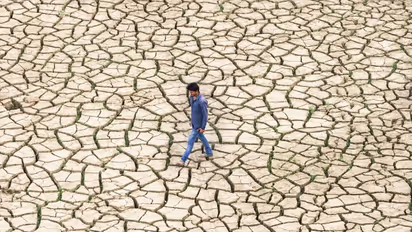SHOCKING! India may face staggering 24.7% GDP loss by 2070 due to climate crisis, study finds

Synopsis
India alone could see a crippling 24.7% hit to its economy by 2070, according to a new report unveiled in the Asian Development Bank's inaugural "Asia-Pacific Climate Report."
Under the shadow of escalating climate change, the Asia-Pacific region faces an alarming economic forecast, with a potential 16.9% GDP decline by 2070 if high-end emissions persist. India alone could see a crippling 24.7% hit to its economy, according to a new report unveiled in the Asian Development Bank's inaugural "Asia-Pacific Climate Report." According to Times of India, the report states that rising sea levels and diminished labor productivity will be among the leading drivers of these losses, hitting low-income and fragile economies the hardest.
The study warns that, should the climate crisis remain unchecked, up to 300 million people could be vulnerable to coastal inundations across Asia and the Pacific, while trillions of dollars' worth of coastal assets face catastrophic annual damage by 2070.
"Climate change has supercharged the devastation from tropical storms, heat waves, and floods in the region, contributing to unprecedented economic challenges and human suffering," said ADB President Masatsugu Asakawa. He urged the need for decisive, coordinated climate action, stressing that the clock is ticking.
The report offers a road map for urgent adaptation financing and outlines strategic policy recommendations for the governments of developing nations within the region. Asakawa highlighted the need for efficient greenhouse gas reductions, noting, "By 2070, climate change under a high-end emissions scenario could cause a total loss of 16.9% of GDP across the Asia and Pacific region. Most of the region would face more than 20%."
According to the report, since 2000, developing Asia has been responsible for the lion's share of the global surge in greenhouse gas emissions. While advanced economies were previously the predominant emitters throughout the 20th century, the early 21st century has seen Asia’s emissions rise faster than any other region, especially from China, which contributed approximately 30% of global emissions in 2021.
The region, home to 60% of the global population, has seen its share of global emissions skyrocket from 29.4% in 2000 to 45.9% in 2021.
The report highlights that increasingly intense and erratic rainfall, coupled with more frequent extreme storms, will drive landslides and floods across the region. "This will be most pronounced in mountainous and steeply sloped areas, such as the border area of India and China, where landslides may increase by 30%-70% under 4.7 degrees Celsius of mean global warming," it stated.
Stay updated with the Breaking News Today and Latest News from across India and around the world. Get real-time updates, in-depth analysis, and comprehensive coverage of India News, World News, Indian Defence News, Kerala News, and Karnataka News. From politics to current affairs, follow every major story as it unfolds. Get real-time updates from IMD on major cities weather forecasts, including Rain alerts, Cyclone warnings, and temperature trends. Download the Asianet News Official App from the Android Play Store and iPhone App Store for accurate and timely news updates anytime, anywhere.